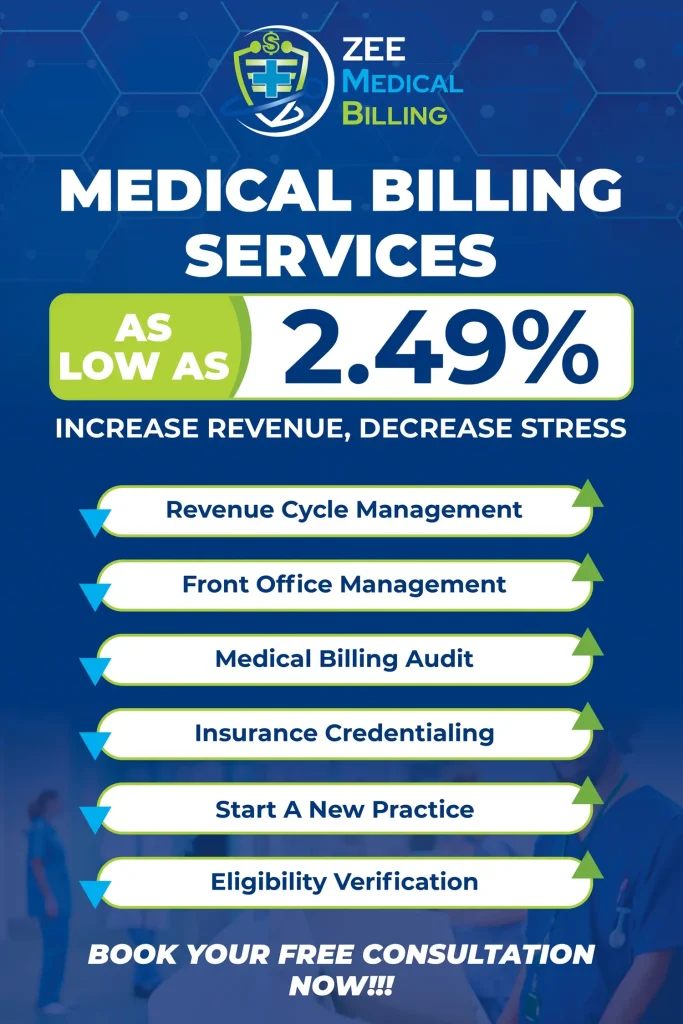Physical therapy billing is a particular area of medical billing that requires a comprehension of explicit methods, insurance contracts, and consistency guidelines. Here are detailed tips from a traditional medical billing organization’s point of view that can help physical therapy practices boost proficiency and income.
Understand and Use Proper Coding
- Stay Current with Codes: Physical therapy relies heavily on procedure codes such as CPT and HCPCS. Common examples include codes for Therapeutic Exercise (97110) and Manual Therapy (97140). Staying current with changes is important to avoid denials.
- Use of modifiers: In physiotherapy, modifiers are often needed to clarify services. For example, use modifier 59 for unique treatment services and GP for services provided as part of a physiotherapy plan.
Read More: Why Your Therapist Needs the Best Health Billing Services
Accurate documentation
- Detailed records: Ensure documentation justifies the medical necessity of the treatment. Each session should include details about the patient’s progress, goals, and services provided.
- Compliance: Follow CMS and private insurer guidelines to avoid audit penalties.
Verify Insurance Coverage
- Eligibility Check: Verify the patient’s insurance benefits, including coverage limits, copayments, and deductibles, before treatment begins.
- Pre-Authorization: Many insurance companies require pre-authorization for physical therapy services. Failure to obtain this may result in the claim being denied.
Optimize Scheduling and Billing
- Integrated Systems: Use software that combines scheduling, billing, and documentation. This ensures that services billed match services recorded.
- Avoid Overbooking: Especially for timed procedures, avoid overlapping time slots that can be flagged for billing errors.
Master Timed and Non-Timed Codes
- Follow the 8-Minute Rule: Medicare and other insurers use the 8-minute rule to accurately calculate timed treatment units.
- Non-timed deliverables: Include assessment codes that are not dependent on session length but require proper justification (e.g., 97161-97163).
Monitor Billing Compliance
- Know your payer’s rules: Each insurance company has specific rules for how and when to bill for physical therapy. Stay informed to avoid non-compliance.
- Avoid upcoding or downcoding: Billing at the correct service level avoids penalties and ensures fair reimbursement.
Staff Training
- Training Programs: Regular training for therapists and billing staff helps them understand the intricacies of coding, documentation, and compliance.
- Reduce Errors: Knowledgeable staff can identify and correct errors before submission, reducing rejections and resubmissions.
Read More: Why You Choose Zee Medical Billing Services in Illinois
Address denials proactively
- Analyse patterns: Identify common reasons for claim denials and address system issues.
- Submit effective appeals: Submit timely, well-documented appeals for denied claims, including detailed patient records and procedural justifications.
Leverage technology
- Use specialized electronic medical records: Electronic medical records tailored for physical therapy improve documentation accuracy and seamlessly integrate with billing systems.
- Analytical tools: Track metrics such as claim acceptance rates, payment cycles, and denial patterns to improve the billing process.
Outsource When Necessary
- Work with an Expert: Consider working with a billing company that specializes in physical therapy to manage claims, maintain compliance, and optimize revenue.
- Focus on Care: Outsourcing allows therapists to focus on patient care, improving overall satisfaction.
Final Thoughts
Executing these billing methodologies can altogether work on the financial performance of your physical therapy practice. Understanding payer rules, keeping up with precise documentation, and proactively managing refusals can guarantee smooth tasks and boost repayment. For further insight and guidance, it can be beneficial to partner with an experienced claims professional.









